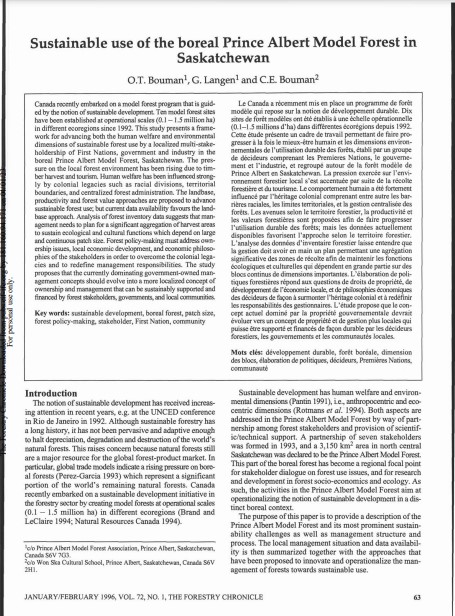Sustainable Use of the Boreal Prince Albert Model Forest in Saskatchewan
Bosque Modelo:
Prince Albert
Temática:
Gestión forestal
Tipo de documento:
Artículo científico
Resumen
Canada recently embarked on a model forest program that is guided by the notion of sustainable development. Ten model forest sites have been established at operational scales (0.1–1.5 million ha) in different ecoregions since 1992. This study presents a framework for advancing both the human welfare and environmental dimensions of sustainable forest use by a localized multi-stake-holdership of First Nations, government and industry in the boreal Prince Albert Model Forest, Saskatchewan. The pressure on the local forest environment has been rising due to timber harvest and tourism. Human welfare has been influenced strongly by colonial legacies such as racial divisions, territorial boundaries, and centralized forest administration. The landbase, productivity and forest value approaches are proposed to advance sustainable forest use; but current data availability favours the land-base approach. Analysis of forest inventory data suggests that management needs to plan for a significant aggregation of harvest areas to sustain ecological and cultural functions which depend on large and continuous patch size. Forest policy-making must address ownership issues, local economic development, and economic philosophies of the stakeholders in order to overcome the colonial legacies and to redefine management responsibilities. The study proposes that the currently dominating government-owned management concepts should evolve into a more localized concept of ownership and management that can be sustainably supported and financed by forest stakeholders, governments, and local communities.
Información Bibliográfica
Autor:
Bouman, OT, G Langen and CE Bouman.
Revista:
Forestry Chronicle
Año:
1996
N°:
1
País :
Canadá
Páginas:
63 - 72
Volumen:
72
Idioma:
Ingles
Palabras claves
sustainable development, boreal forest, patch size, forest policy-making, stakeholder, First Nation, community





